For a lot of animals speed is essential to their survival and whether they can outrun a predator depends on how fast they can run. When we think of the fastest animals we probably instantly think of a cheetah which is the fastest land mammal, but surprisingly there are some animals that can actually travel faster. North America is home to many different fantastic animals spread across its vast landscape and some of them can move pretty fast. So, here we have listed 10 of the fastest animals in North America.
#10: Grey Fox
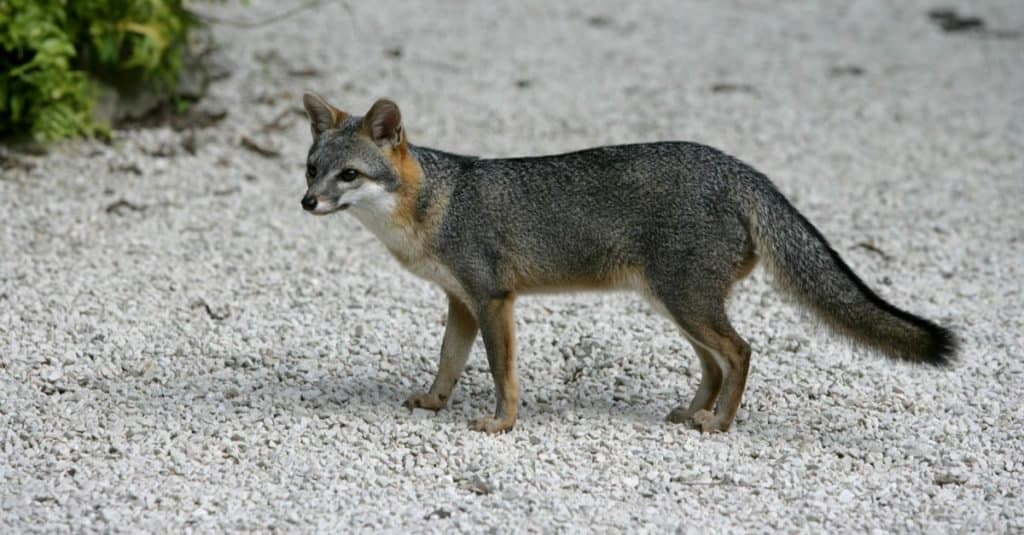
Gray fox
©Erni/Shutterstock.com
Grey foxes are small mammals that weigh around 5 pounds, but can reach speeds of around 42 mph when running. They are found in southern Canada and across most of the US and prefer rocky, wooded areas. Grey foxes are mostly grey, but have reddish brown sides and a black stripe down their tails. These foxes are omnivores and eat fruit as well as hunting down prey such as birds, voles, shrews, rabbits, and hares. Females make their dens in logs, rocks, or trees and give birth to between one and seven cubs each year. Gray foxes are also excellent climbers and can scale trees and jump from branch to branch to escape from predators such as coyotes.
#9: Coyote
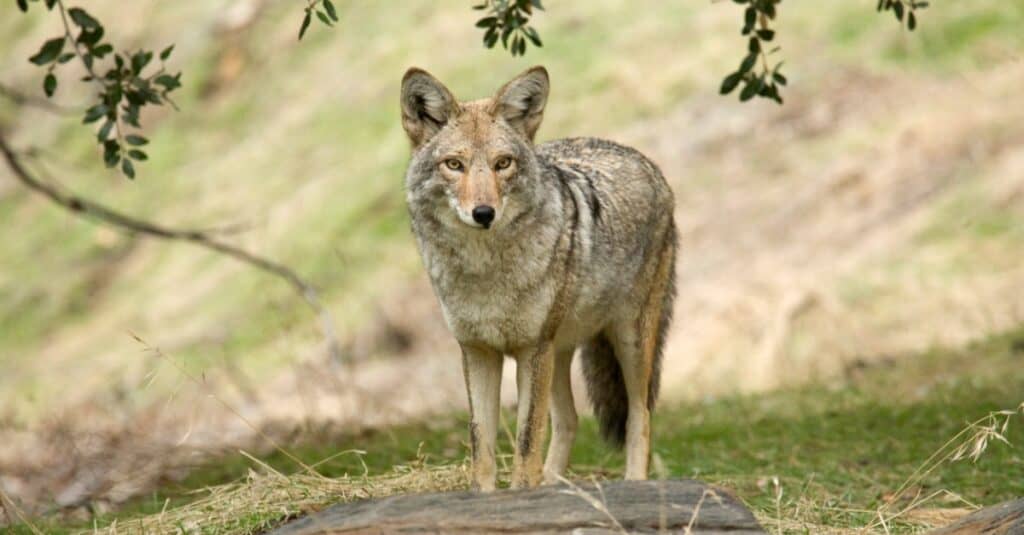
Closely related – coyotes are a relative of wolves
©iStock.com/Fabiomichelecapelli
Coyotes are widespread across North America and are slightly faster than grey foxes, reaching speeds of around 43 mph. Coyotes are closely related to wolves and have a grey-brown appearance with a long, bushy tail. They are highly adaptable and live in a range of different habitats, including grasslands, forests, and rocky mountain regions. However, coyotes don’t often make their own dens, preferring to live in dens that have been abandoned by other animals such as badgers or foxes. These dens are usually in caves or logs, or some other rocky crevice. Coyotes are carnivores and eat a range of deer, elk, moose, birds, rabbits, and some reptiles. Wolves and mountain lions are the main predators of coyotes, but bears and alligators can also be a threat.
#8: Mule Deer
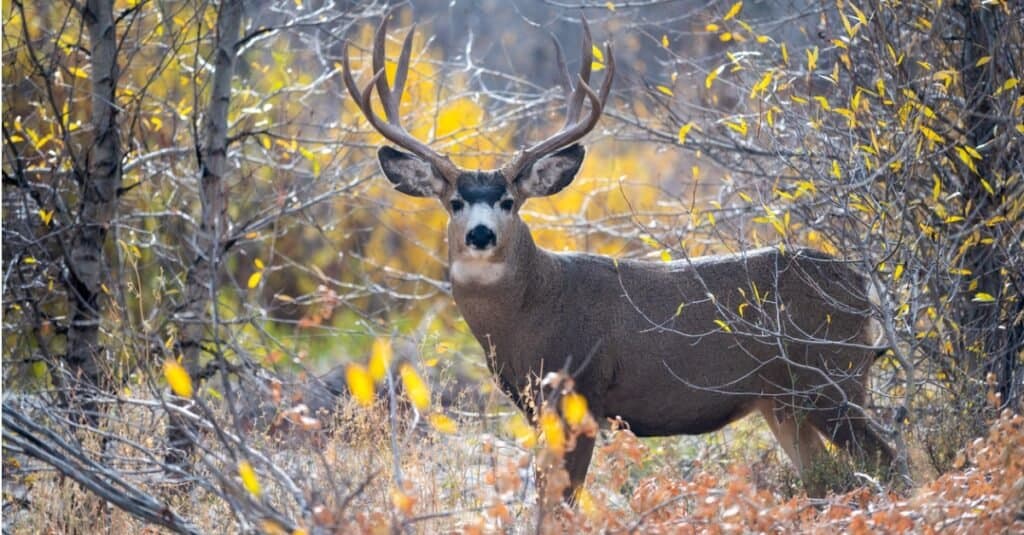
A male mule deer
©iStock.com/EEI_Tony
Mule deer are named for their large ears like those of a mule’s and are native to western North America. Although they are not the biggest, standing around 3 feet high at the shoulder, mule deer can reach a speed of 45 mph. Mule deer can easily be distinguished from other deer by their large ears, black tails, and the forked antlers on the males. Most males shed their antlers in February and they begin to grow again almost immediately. Females give birth in the spring and usually have to two fawns, although only one if it is their first time giving birth. The main predators of mule deer are wolves, coyotes, and mountain lions. Bears and bobcats sometimes attack healthy adults, but usually prey only on the fawns and any old or sick animals.
#7: Elk

Bull Elk bugling for does.
©Wesley Aston/Shutterstock.com
Elk are larger than mule deer – with a shoulder height of more than 4 feet – but also reach speeds of around 45 mph. Although they used to be widespread across North America, they are now found mainly in the western areas. Elk prefer to live in forest areas, or on the edge of forests, and graze on grass, plants, and leaves. Elk have a dark brown appearance and males have large antlers which are shed yearly and used for rutting with. With the exception of breeding season, herds are usually divided by gender, with males in one herd and females with young in another. Wolves, coyotes, bobcats, mountain lion, and bears are the main predators of elk.
#6: Mountain Lion
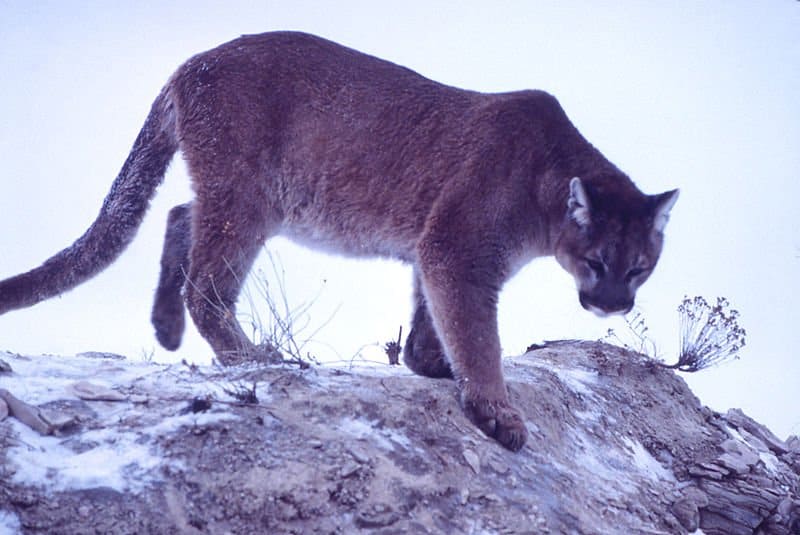
Mountain Lion
©K Fink – Public Domain
Mountain lions, also known as cougars, are the fastest land predator in North America. These large, sandy colored cats are solitary animals and are highly adaptable, capable of living in virtually any habitat, including mountains, forests, and deserts. Mountain lions are ambush predators and stalk their prey before leaping on their back and delivering a lethal bite to the neck. However, they are also capable of reaching the incredible speed of 50 mph when they need to, which means it’s no surprise that they are capable of killing anything they can catch, including deer, elk, moose, and even horses. Mountain lions have no known predators, although wolves might take cubs if the opportunity arose.
#5: Quarter Horse
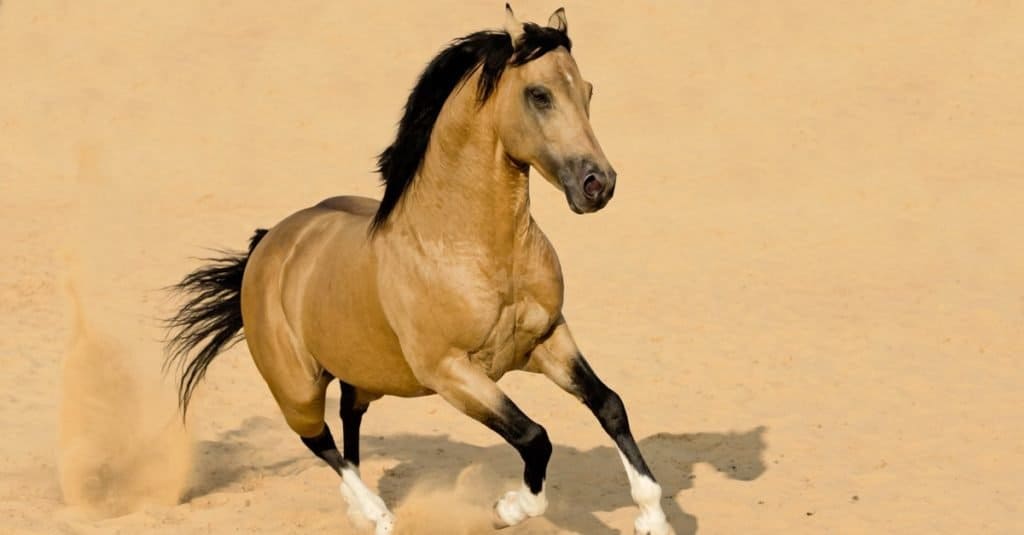
American Quarter Horse Stallion running in an arena. Quarter horses are incredibly versatile. From barrel racing and roping to jumping and dressage, they’re top performers.
©jacotakepics/Shutterstock.com
Quarter horses are famous for reaching incredible speeds over the distance of a quarter of a mile, hence their name, and their top speed is 55 mph. With their compact body and excellent temperament, quarter horses are the most popular horse in America and are used for a wide range of jobs. Quarter horses have long been used for driving cattle and are an essential part of life on working ranches. While they are still used on ranches, they are also used for competing in rodeos, barrel racing, and other disciplines such as show jumping
#4: Pronghorn
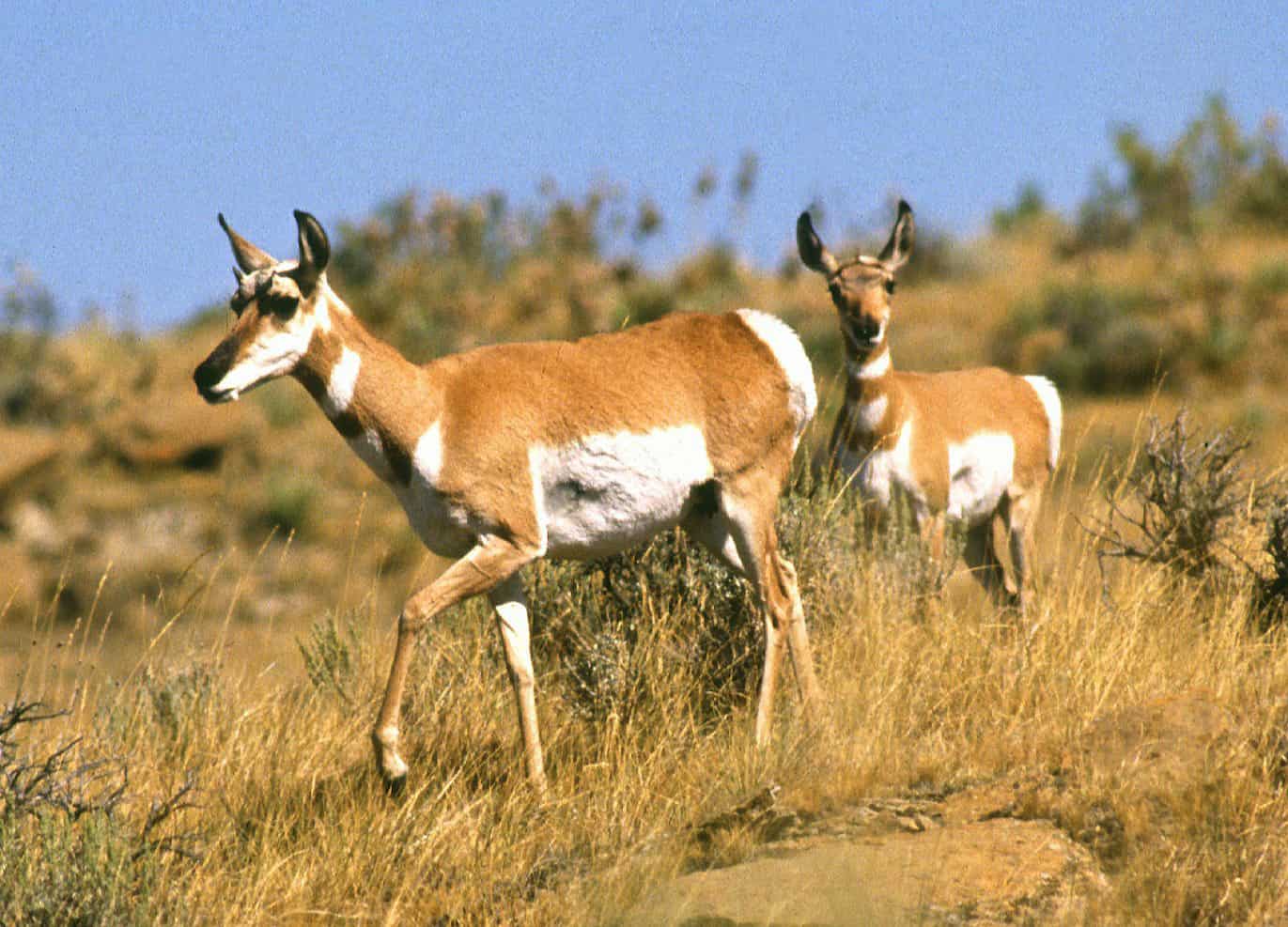
Female pronghorns
©Jack Dykinga / Public domain, from Wikimedia Commons, the free media repository – License
The pronghorn is the fastest land mammal in North America and can reach 55 mph. Although its top speed is the same as the quarter horse, the pronghorn can maintain its speed over a long distance, meaning it excels at endurance as well as speed. Pronghorns are often mistaken for antelopes, but they are not actually antelope and are the only surviving member of the family group Antilocapridae. They have a tan body that is similar to that of a deer, but have white patches on their rump, sides, bellies, and the underside of their throats. Males have upright horns which are around 12 inches long and look like prongs, hence their name. Females also have horns, although theirs are much smaller and are often only around 4 inches long. Pronghorns live in herds mainly in the grasslands and deserts and their predators are wolves, coyotes, mountain lions, and bears.
#3: Anna’s Hummingbird
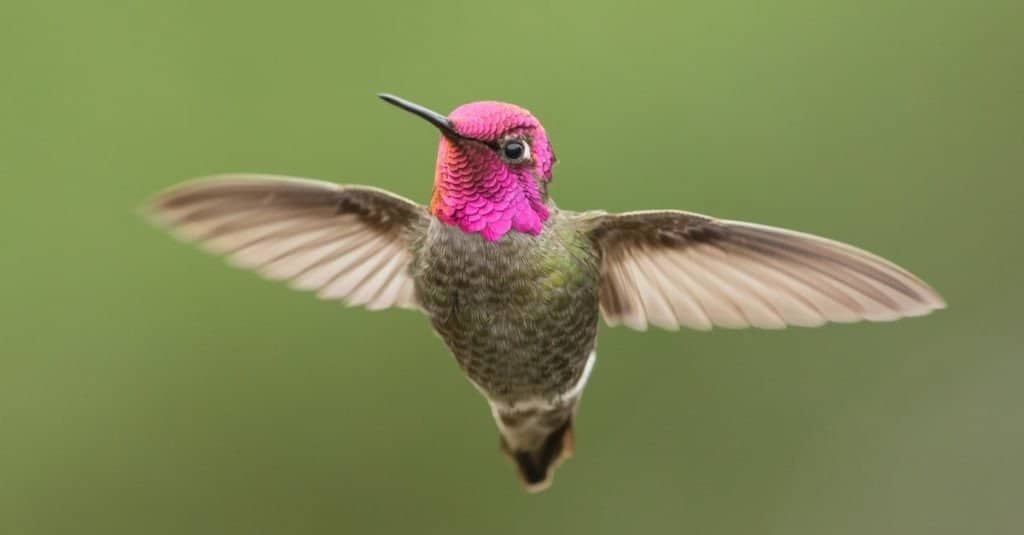
Male Anna’s hummingbird
©Keneva Photography/Shutterstock.com
Anna’s hummingbird is a medium-sized hummingbird with a wingspan of around 4.7 inches. Anna’s hummingbirds are native to the coastal areas of western North America and can fly at a top speed of 61 mph. These hummingbirds have grey chests and bellies and a green back. Males have a reddish-pink crown and a tail that is slightly forked. Anna’s hummingbirds feed on small flying insects and nectar which they eat using their incredibly long tongue. Nests are usually near a source of nectar and are made in the branches of trees where they lay two eggs which take around 16 days to hatch. Anna’s hummingbirds are not considered to be under threat and their population is stable and healthy.
#2: Golden Eagle
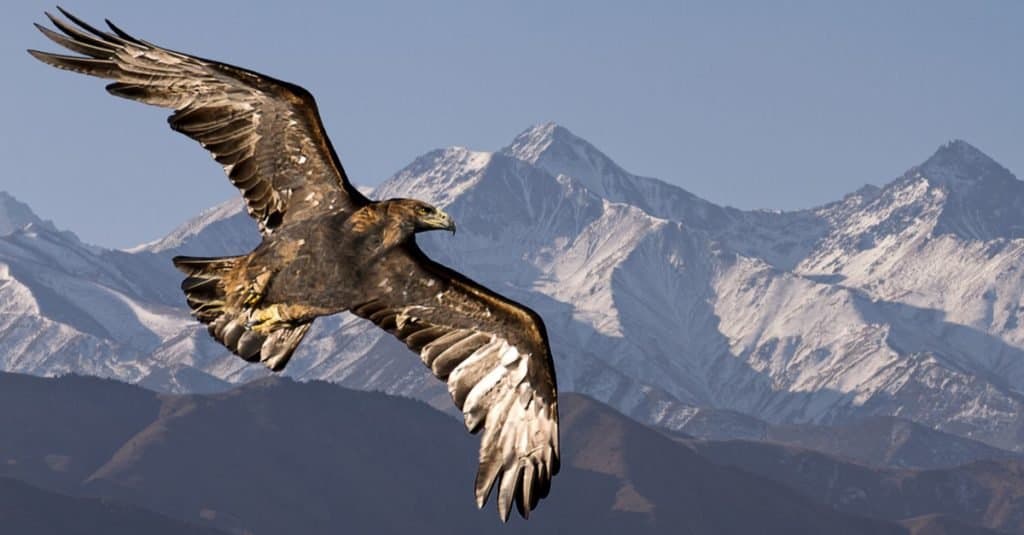
Golden eagles can maintain surprising speeds
©MehmetO/Shutterstock.com
Some birds can dive at tremendous speeds, such as the peregrine falcon which can reach speeds of up to 242 miles per hour! However for this ranking of the fastest animals in North America we’re looking at horizontal speed. That is, how fast can a bird fly across the Earth. On that standard, golden eagles are one of the fastest birds in the world. Golden eagles can fly up to 80 miles per hour horizontally while their dives can reach 200 miles per hour! These large birds of prey can be found year-round in the Western United States.
#1: Mexican Free-tailed Bat
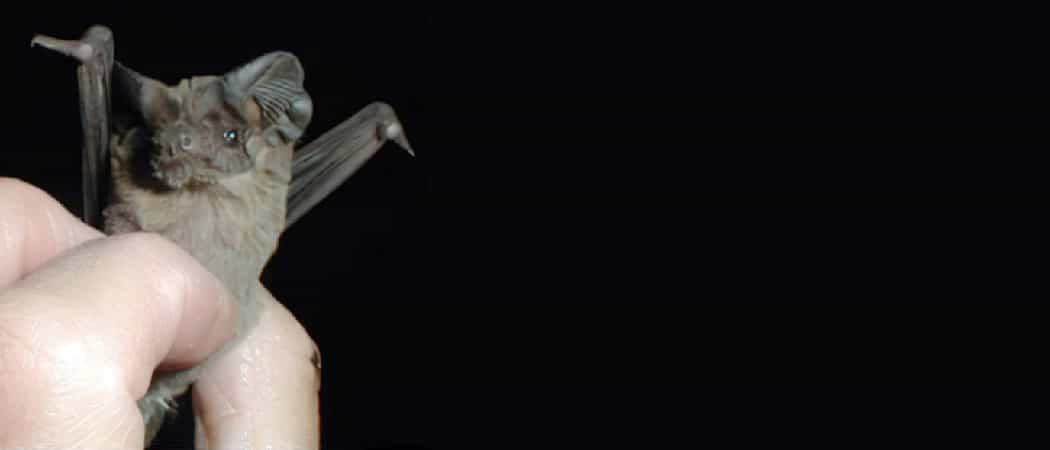
A Mexican free-tailed bat
©NPS / public domain – License
The fastest animal in North America is the Mexican free-tailed bat. These bats are only 3.5 inches long but can reach the incredible speed of 100 miles per hour! Mexican free-tailed bats get their name from their tail which makes up around half of their length. They also have wide, round ears which they use to find their prey with by echolocation. Mexican free-tailed bats eat a range of insects such as dragonflies, beetles, moths, flies, wasps, and ants, and they actually play an important role in the protection of crops as they often eat up to two-thirds of their body weight in insects every night. Mexican free-tailed bats prefer to roost in caves, although any buildings with dark recesses are also suitable. They roost in huge numbers, which makes them vulnerable to habitat destruction, but their population remains healthy and they are not considered to be under threat.
The photo featured at the top of this post is © Jen DeVos/Shutterstock.com
Thank you for reading! Have some feedback for us? Contact the AZ Animals editorial team.






